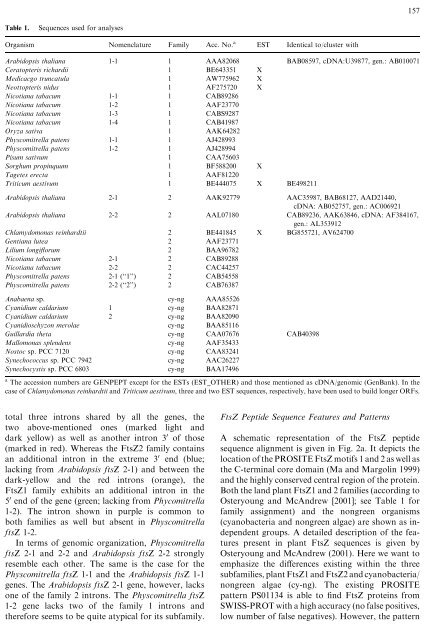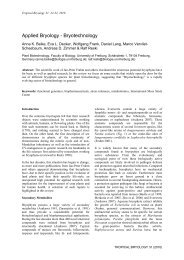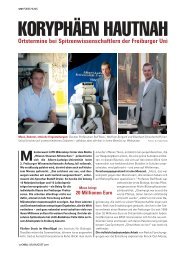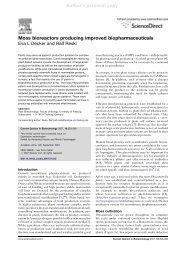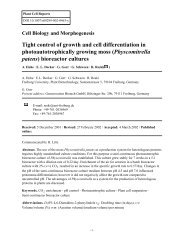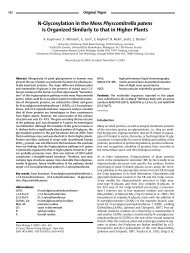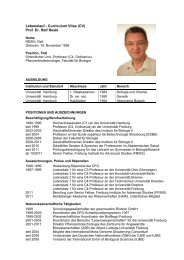Diversification of ftsZ During Early Land Plant Evolution
Diversification of ftsZ During Early Land Plant Evolution
Diversification of ftsZ During Early Land Plant Evolution
You also want an ePaper? Increase the reach of your titles
YUMPU automatically turns print PDFs into web optimized ePapers that Google loves.
157<br />
Table 1.<br />
Sequences used for analyses<br />
Organism Nomenclature Family Acc. No. a EST Identical to/cluster with<br />
Arabidopsis thaliana 1-1 1 AAA82068 BAB08597, cDNA:U39877, gen.: AB010071<br />
Ceratopteris richardii 1 BE643351 X<br />
Medicacgo truncatula 1 AW775962 X<br />
Neottopteris nidus 1 AF275720 X<br />
Nicotiana tabacum 1-1 1 CAB89286<br />
Nicotiana tabacum 1-2 1 AAF23770<br />
Nicotiana tabacum 1-3 1 CABS9287<br />
Nicotiana tabacum 1-41 CAB41987<br />
Oryza sativa 1 AAK64282<br />
Physcomitrella patens 1-1 1 AJ428993<br />
Physcomitrella patens 1-2 1 AJ428994<br />
Pisum sativum 1 CAA75603<br />
Sorghum propinquum 1 BF588200 X<br />
Tagetes erecta 1 AAF81220<br />
Triticum aestivum 1 BE444075 X BE498211<br />
Arabidopsis thaliana 2-1 2 AAK92779 AAC35987, BAB68127, AAD21440,<br />
cDNA: AB052757, gen.: AC006921<br />
Arabidopsis thaliana 2-2 2 AAL07180 CAB89236, AAK63846, cDNA: AF384167,<br />
gen.: AL353912<br />
Chlamydomonas reinhardtii 2 BE441845 X BG855721, AV624700<br />
Gentiana lutea 2 AAF23771<br />
Lilium longiflorum 2 BAA96782<br />
Nicotiana tabacum 2-1 2 CAB89288<br />
Nicotiana tabacum 2-2 2 CAC44257<br />
Physcomitrella patens 2-1 (‘‘1’’) 2 CAB54558<br />
Physcomitrella patens 2-2 (‘‘2’’) 2 CAB76387<br />
Anabaena sp. cy-ng AAA85526<br />
Cyanidium caldarium 1 cy-ng BAA82871<br />
Cyanidium caldarium 2 cy-ng BAA82090<br />
Cyanidioschyzon merolae cy-ng BAA85116<br />
Guillardia theta cy-ng CAA07676 CAB40398<br />
Mallomonas splendens cy-ng AAF35433<br />
Nostoc sp. PCC 7120 cy-ng CAA83241<br />
Synechococcus sp. PCC 7942 cy-ng AAC26227<br />
Synechocystis sp. PCC 6803 cy-ng BAA17496<br />
a The accession numbers are GENPEPT except for the ESTs (EST_OTHER) and those mentioned as cDNA/genomic (GenBank). In the<br />
case <strong>of</strong> Chlamydomonas reinhardtii and Triticum aestivum, three and two EST sequences, respectively, have been used to build longer ORFs.<br />
total three introns shared by all the genes, the<br />
two above-mentioned ones (marked light and<br />
dark yellow) as well as another intron 3 0 <strong>of</strong> those<br />
(marked in red). Whereas the FtsZ2 family contains<br />
an additional intron in the extreme 3 0 end (blue;<br />
lacking from Arabidopsis <strong>ftsZ</strong> 2-1) and between the<br />
dark-yellow and the red introns (orange), the<br />
FtsZ1 family exhibits an additional intron in the<br />
5 0 end <strong>of</strong> the gene (green; lacking from Phycomitrella<br />
1-2). The intron shown in purple is common to<br />
both families as well but absent in Physcomitrella<br />
<strong>ftsZ</strong> 1-2.<br />
In terms <strong>of</strong> genomic organization, Physcomitrella<br />
<strong>ftsZ</strong> 2-1 and 2-2 and Arabidopsis <strong>ftsZ</strong> 2-2 strongly<br />
resemble each other. The same is the case for the<br />
Physcomitrella <strong>ftsZ</strong> 1-1 and the Arabidopsis <strong>ftsZ</strong> 1-1<br />
genes. The Arabidopsis <strong>ftsZ</strong> 2-1 gene, however, lacks<br />
one <strong>of</strong> the family 2 introns. The Physcomitrella <strong>ftsZ</strong><br />
1-2 gene lacks two <strong>of</strong> the family 1 introns and<br />
therefore seems to be quite atypical for its subfamily.<br />
FtsZ Peptide Sequence Features and Patterns<br />
A schematic representation <strong>of</strong> the FtsZ peptide<br />
sequence alignment is given in Fig. 2a. It depicts the<br />
location <strong>of</strong> the PROSITE FtsZ motifs 1 and 2 as well as<br />
the C-terminal core domain (Ma and Margolin 1999)<br />
and the highly conserved central region <strong>of</strong> the protein.<br />
Both the land plant FtsZ1 and 2 families (according to<br />
Osteryoung and McAndrew [2001]; see Table 1 for<br />
family assignment) and the nongreen organisms<br />
(cyanobacteria and nongreen algae) are shown as independent<br />
groups. A detailed description <strong>of</strong> the features<br />
present in plant FtsZ sequences is given by<br />
Osteryoung and McAndrew (2001). Here we want to<br />
emphasize the differences existing within the three<br />
subfamilies, plant FtsZ1 and FtsZ2 and cyanobacteria/<br />
nongreen algae (cy-ng). The existing PROSITE<br />
pattern PS01134is able to find FtsZ proteins from<br />
SWISS-PROT with a high accuracy (no false positives,<br />
low number <strong>of</strong> false negatives). However, the pattern


